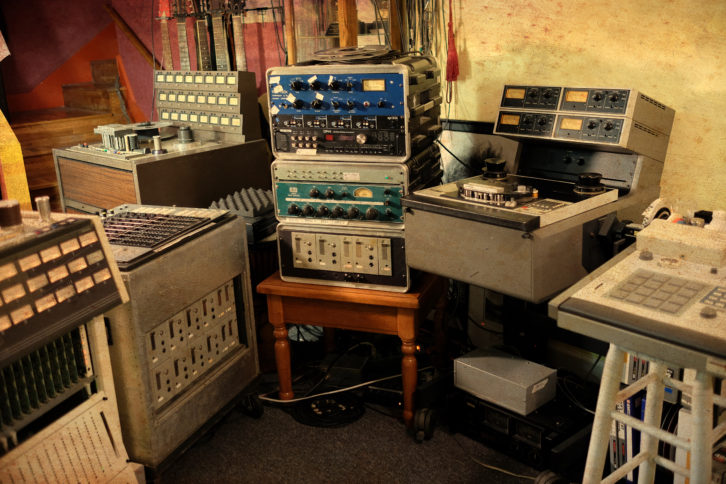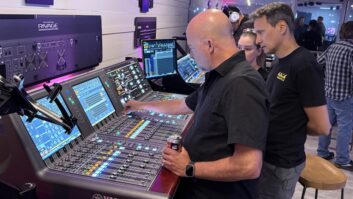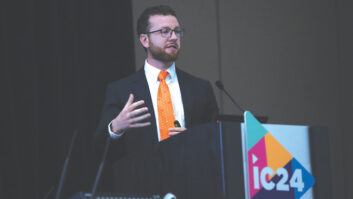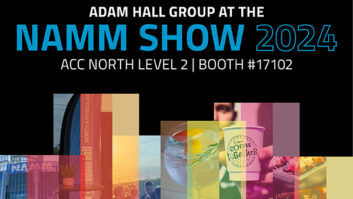
Mix last spoke with engineer/producer/musician Ray Kennedy about his work with Lucinda Williams this past February for a “Classic Tracks” article on her 1998 masterpiece Car Wheels on a Gravel Road. Twenty-one years later, this musical friendship has produced a new project—Williams’ heavy, rocking new album, Good Souls Better Angels (Thirty Tigers, produced by Williams, Kennedy and Tom Overby)—that features a darker aspect of Williams’ singing and songwriting, with moody, distorted guitar parts and intense lyrics on songs like “Man Without a Soul.”
“Lu and Tom called to say they’d just gotten back from a tour,” Kennedy recalls. “They said, ‘We have three or four days. Can we come in and do some recording? How about tomorrow?’ We worked in four different batches of dates and songs, but it was a very focused record about this world we live in.”
Kennedy co-produced, recorded and mixed the album in his Room and Board Studio, Nashville, which has taken on different forms and locations over the years. Early in his production career, Kennedy had a studio on Music Row, and then he expanded to a residential facility 45 minutes outside of town. In 2008, he relocated again, to the Berry Hill neighborhood.

“I have to thank the Nashville flood [2010] for part of this studio,” Kennedy says. “When I got this place, it was with the idea of having two two-bedroom apartments on the third floor—to have a downtown residential studio. The studio was on the two lower floors.
“When I got flooded, I had to evacuate for six months: tear the walls and floors out, and do mitigation with high-velocity fans and dehydrators,” he continues. “Much of my vintage gear was underwater, so I rented big metal storage containers and put all of my tape machines, guitar amps, consoles and other vintage stuff inside with dehydrators to let everything dry out; most all of that gear still works today because I was patient enough to dry everything out thoroughly. But all the newer electronic equipment, from computers to outboard processing, was destroyed.”
Necessity being the mother of invention, Kennedy then moved a lot of his rescued equipment into the upper floor of the studio while the ground floor was being restored. He installed his 1962 Telefunken recording console and his collection of vintage outboard gear in a loft space, then carried on mixing records. He also outfitted another upstairs room with instruments and recording gear so that he could do some tracking if needed.
Before long, he realized he had created a totally revised, Abbey Road 2-esque floor plan, with a control room and smaller recording space upstairs, and a large live space below. What started out as a makeshift solution became his preferred layout.

“The big room downstairs has 22-foot ceilings, and that’s where I keep close to 100 electric and acoustic guitars, mandolins, basses and other stringed instruments hanging on the walls, plus several drum kits, percussion instruments and classic keyboards,” Kennedy says. “That’s part of the sound of my room, with everything ringing off those instruments and bouncing back into the room.
“When Lucinda’s drummer, Butch Norton, asked, ‘Do I need to bring my whole kit?’ I said, ‘You should check out my Gretsch drums.’ Butch chose to bring his cymbals, a few snare drums, percussion and his stick bag. We relied on several of my vintage snare drums from the ’40s through the ’60s, especially a 1957 Ludwig Supraphonic.”
Kennedy set up Norton, as well as guitarist Stuart Mathis and bass player David Sutton, in that large downstairs recording room (Studio A), while Williams sang and played guitar in an adjacent, custom-built, anechoic vocal booth.
“But after the first bit of recording, she said, ‘Ray I feel cramped in here,’ he explains. “I said, ‘I have another room upstairs where you’ll be really comfortable. It’s a big open space with nice acoustics.’ That’s how we made most of the record: Everything was recorded live, including Lu’s vocals. I’m upstairs in the control room with Tom, she’s in the room off the control room, the rest of the band is downstairs in one big room, and the amps were back in my piano room. I demonstrated to Stuart what my ’65 Fender Pro Reverb amp sounded like on hardwood floors, positioned to throw the sound under my 1928 Steinway piano to resonate the soundboard. Every other vibrating instrument in the room becomes part of your sound.”
Williams sang into a Neumann U67—the same mic Kennedy chose for her on their very first session, for a duet with Steve Earle in 1996—through an API 312 mic preamp, though they switched to a Telefunken V76 pre on songs that needed a smoother, more open top end.
Williams often played Kennedy’s ’69 Telecaster through his ’59 Tweed Gibson Ranger tube amp while she sang during live tracking. That sound was captured through an RCA 74B ribbon mic, as was Mathis’ Fender Pro Reverb amp—during live tracking and during the few overdubs where Mathis filled in unique, moody guitar lines and effects.

“When Lucinda played acoustic guitar, she used my 1950 Gibson J-45 or her own J-45 that she plays on live shows. I miked that with a Schoeps 1958 CM-65 or a Miktek C5 for a drier, tight sound,” says Kennedy.
On Sutton’s bass, Kennedy used a sort of secret weapon: “In 1996, I ran across this new direct box that Glen Pace was building in Texas,” the engineer/producer says. “It’s called Starplex and it’s based on a Class A all-discrete circuit, with custom-wound nickel transformers. I bought two of the prototypes. They never went into production to make them available commercially, so there were never more than 50 or so of these things, but I still have the two that I’ve been using on bass and electric keyboards ever since. That Starplex DI into my ’50s Altec tube preamp is my favorite bass sound.”
The beautiful record that Williams and band made with Kennedy makes a strong statement lyrically and sonically, and a couple of the musicians wanted to re-create those sounds on tour.
“Lucinda loved the sound of the electric guitar so much she wanted to get one of those Gibson Ranger tube amps to take on the road, so Stuart found one in great shape from the same year and they bought it off eBay, and she plays it on the road now,” Kennedy says. “David Sutton liked the sound of the Starplex so much, I found him one and he takes that on the road. Discoveries happen in the studio, and it’s great when musicians discover sounds that they want to take with them.”







